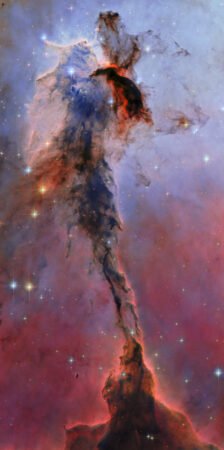Top Highlights
-
New Image Release: A reprocessed image from April 18, 2025, reveals a massive 9.5-light-year-tall pillar of cold gas and dust in the Eagle Nebula, also known as Messier 16.
-
Eagle Nebula Overview: The Eagle Nebula is part of the Milky Way and features sculpted dusty clouds shaped by radiation and winds from nearby young stars.
-
Formation of Nebulae: Nebulae develop their intricate forms when dense gas areas are shielded from the powerful radiation and stellar winds created by infant stars.
- Visual Impact: The striking pillar of dust captured in this image exemplifies the stunning beauty and complexity of the phenomena occurring in star-forming regions of the universe.
On April 18, 2025, astronomers unveiled a stunning new image of a cosmic pillar nestled in the Eagle Nebula. This pillar, stretching 9.5 light-years tall, consists of cold gas and dust. Scientists processed the image to highlight the intricate details of this massive structure.
The Eagle Nebula, also known as Messier 16, is rich in sculpted, dusty clouds. Astronomers observe these fascinating formations across the Milky Way. However, the Eagle Nebula stands out due to its dramatic shapes. These shapes arise when intense radiation and winds from nearby young stars sculpt the gas and dust.
Interestingly, denser regions of gas endure the powerful forces better than less dense areas. As a result, they survive the stellar onslaught to create stunning formations like the pillar. This process not only captivates stargazers but also informs researchers about star formation.
Studying the Eagle Nebula and similar celestial bodies furthers technological development. Insights from these cosmic wonders help scientists improve imaging technology. As a result, researchers can analyze distant galaxies and other astronomical phenomena with greater accuracy.
Ultimately, discoveries in the cosmos enhance our understanding of the universe. They also inspire innovations that could eventually benefit life on Earth, enriching our knowledge and improving technology for future generations.
Stay Ahead with the Latest Tech Trends
Stay informed on the revolutionary breakthroughs in Quantum Computing research.
Access comprehensive resources on technology by visiting Wikipedia.
SciV1

